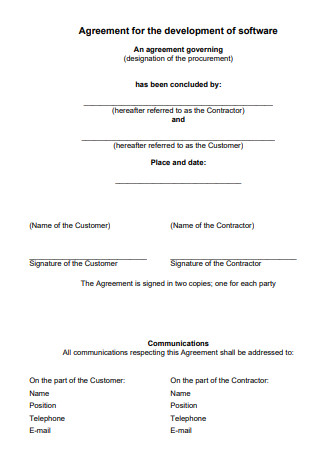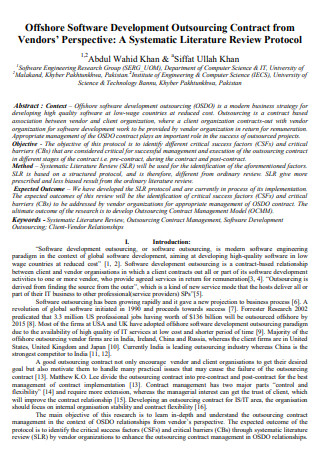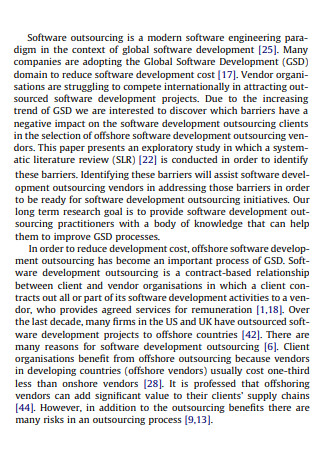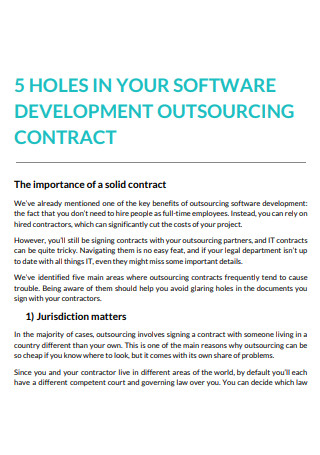5+ SAMPLE Software Development Outsourcing Contract
-

Sample Software Development Outsourcing Agreement
download now -

Software Development Outsourcing Contract Overview
download now -

Software Development Outsourcing Contract
download now -

Free Software Development Outsourcing Contract
download now -

Offshore Software Development Outsourcing Contract
download now -

Sample Software Development Outsourcing Contract
download now
FREE Software Development Outsourcing Contract s to Download
5+ SAMPLE Software Development Outsourcing Contract
Software Development Outsourcing?
Benefits of Outsourcing Software Development Services
Tips For Software Development Outsourcing
How To Create Your Software Development Outsourcing Contract
FAQs
Is it possible to outsource data?
What does outsourcing look like in practice?
How does outsourcing help you save money?
What Is Software Development Outsourcing?
Software Development Outsourcing is a term that refers to an arrangement in which a company hires an external software development company to efficiently complete all duties associated with a software development project that may be completed in-house. According to research, more than two-thirds (68 percent) of large US consumer products companies currently outsource some percentage of their workforce.
Benefits of Outsourcing Software Development Services
Outsourcing is already common among the industry’s largest brands, with many companies outsourcing a significant percentage of their operations. Now, smaller developers are following suit — and other businesses worldwide are taking notice. Additional capacity, achieving more significant corporate objectives, saving money, and gaining access to expertise not currently available in-house. However, numerous problems and potential drawbacks are associated with ineffective outsourcing contracts and agreements, resulting in low staff morale, poorly written code, missed deliveries, and, ultimately, a low return on investment. Consider the benefits of outsourcing software development.
Tips For Software Development Outsourcing
Software development outsourcing has exploded in popularity over the last couple of decades. The majority of global firms outsource a variety of IT functions! The following are some helpful bits of advice to assist you in selecting the proper partner and ensuring that your outsourcing decision is a sound one for your business’s growth:
1. Specify your requirements.
To begin, you should carefully define your job requirements for outsourcing a software or application development project. Defining your needs makes it easier to identify the technologies or methodologies that best meet your business’s objectives and expectations.
2. Compile a list of all available technologies.
After determining your requirements, compile a list of all available technologies. You can choose from various database types, front-end technologies, hosting servers, and back-end technologies. When you select the appropriate technology, you will obtain specific costs and duration estimates for the development project. Additionally, compiling a list of technologies simplifies the process of locating an outsourcing partner. If your organization lacks a dedicated team with expertise in software development technologies, ensure that your prospective partner possesses an extensive understanding of these disciplines. Keep in mind the technology, projects, and clients with which the outsourcing firm has dealt.
3. Check online for company reviews.
While shortlisting a team to produce your software product, you should conduct an online search for the team’s business reviews. Apart from visiting their corporate websites, LinkedIn profiles, or other social media accounts, one excellent option is to search for accurate evaluations on reputable websites that aggregate company profiles and provide authentic customer reviews. Conducting a favorable and honest work assessment is critical because you want to guarantee that the software development firm you consider has simplified its clients’ companies through their software development solutions.
4. Discuss the time and cost involved in the project’s development.
After selecting a software development business for your next project, it’s time to review the project’s expenses and timeline and ensure that everything is crystal clear. It will help if you discuss everything in detail, including your price model and all extra charges. If everything is transparent and discussed, including the cost, duration, delivery, and release date of the application, among other aspects, you can proceed.
5. Get started with a trial project.
Before choosing a development agency, you must ascertain its capabilities. Begin by requesting that the teamwork on a test project. Their functionality and performance can assist you in deciding whether to continue using them. Conducting a test project may need you to invest both time and resources. However, it is beneficial to have a clear picture of how the collaborative experience will unfold.
6. Inquire about post-development support.
This concludes our list of outsourcing tips for software development projects. If possible, request post-development help from your development partner, whether via phone or email and chat. Ascertain that they offer support or, in the alternative, that the outsourced company adequately trains your personnel on how to resolve future challenges.
How To Create Your Software Development Outsourcing Contract
Remember that this contract aims to ensure that the client and developer know the details that must be agreed upon. This means that the agreement must detail everything from the parties involved in the transaction to the client’s expectations of the contractor. As long as the document has all the necessary information, one may be certain that all example agreements relevant to the transaction between the parties have been comprehended and approved. With that in mind, the following steps will assist you in creating an effective software development outsourcing contract:
Step 1: Determine the involved parties.
The first step that must be completed promptly is to identify who is participating in the necessary agreements. This section defines who the “customer” is and who the “contractor” is. This is necessary since it will make identifying who should be doing what for whom is much easier. Because a circumstance may arise in which the parties’ identities are required. For instance, any lawsuit or complaint brought against either party member will require proof of the parties’ names and duties. Ensure that you begin by recording the client’s name. Whether the software developer is contracting with a firm or an individual, it is critical to register the client’s full name. If the contractor is working for a single individual or a firm, add the individual’s first and last name so that the contractor can quickly determine who they are working for. The contractor is then required to include their name in the outsourcing contract. Again, ensure that it is your full name since clients will want to know who they are dealing with.
Step 2: Distribute what a software developer has to offer.
At this stage in the contract, information about the software developer’s responsibilities for the client must be presented. This is necessary so that the contractor understands what needs to be done. Remember that the type of services required will be determined by the contractor’s software knowledge and the client’s requirements. Given that each client has specific needs, all parties involved must discuss the service. This is where one must understand what type of program must be produced, its significant features, what it is intended to do for users, and much more. This will help the contractor understand the expectations that must be met. After everything has been established, the next step is to write down all of the duties assigned to the software developer. Make sure you write down all of them as clearly as possible so that both sides know what needs to be done once the agreement is finalized.
Step 3: Describe the termination issues.
Either the software developer or the client can end the contract at any moment for their reasons. However, neither party may terminate the agreements as they like, which means they’ll need to know when they can do so. That is why it is critical to include a statement outlining the concerns surrounding when either party may terminate the contract or the circumstances that could result in contract termination. You must go into depth and explain this as thoroughly as possible since both parties will want to understand what could result in the termination of the contract. You must establish criteria for both the buyer and seller if they decide to discontinue the service entirely. For instance, if the client chooses to terminate immediately, they will still be required to pay a quantity equal to the value of the service previously rendered. Then it would help if you list the various causes for contract termination. You can specify that if either party violates a specified agreement, the contract will automatically dissolve. Describe the possible causes in detail so that neither party is startled.
Step 4: Make a note of the payment details.
This section will detail how the client will compensate the service provider. The software developer will want to read this part, outlining the payment contracts and how everything will be paid. The customer will also like to read this section because it will teach them the specifics of what is owed and how to use the information to determine if everything lines up. Also, there must be a description of the services offered and their particular costs. The contractor might decide whether to charge per hour for these services or a flat rate for everything. After you’ve recorded everything, proceed to provide the full payment. Finally, outline the methods by which the client may compensate the contractor for the software created. This is ultimately determined by the service provider, as they will be getting the funds. If you’re interested in learning about the other types of contracts you can enter, you must browse our website. The site contains numerous articles, each of which should include the information you’re looking for. Ensure that you read the ones you’ve picked attentively to ensure that you get the most out of what they have to offer.
FAQs
Is it possible to outsource data?
Organizations outsource data analytics to service providers based on the data they provide to the outsourcing company. According to industry analysis, demand for the service is increasing.
What does outsourcing look like in practice?
Human resource management, facility management, supply chain management, accounting, customer support and service, marketing, computer-aided design, research, design, content writing, engineering, diagnostic services, and legal paperwork are all examples of popular outsourcing operations.
How does outsourcing help you save money?
Outsourcing is typically used to reduce costs by 20%-30%. Certain operations, such as data entry or document processing, are too costly and time-consuming to perform in-house for many firms. The benefits of outsourcing can be summarized as flexibility, quality, and cost savings.
There are numerous advantages to outsourcing software development. However, it is vital to state that you must be curious about the company you wish to collaborate with. Examine their level of experience, inquire about their methodologies, collaboration processes, and your ability to participate in the project, among other things. These factors vary for each firm. With due diligence, you may cultivate a partnership that will catapult your firm to new heights.
